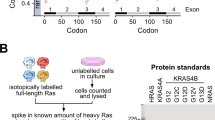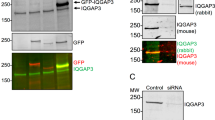Abstract
The ubiquitously expressed major Ras isoforms: H-, K- and N-Ras, are highly conserved, yet exhibit different biological outputs. We have compared the relative efficiencies with which epidermal or hepatocyte growth factor activates Ras isoforms and the requirement for specific isoforms in the activation of downstream pathways. We find that the relative coupling efficiencies to each Ras isoform are conserved between stimuli. Furthermore, in both cases, inhibition of receptor endocytosis led to reduced N- and H-Ras activation, but K-Ras was unaffected. Acute knockdown of each isoform with siRNA allows endogenous Ras isoform function and abundance to be probed. This revealed that there is significant variation in the contribution of individual isoforms to total Ras across a panel of cancer cell lines although typically K⩾N≫H. Intriguingly, cancer cell lines where a significant fraction of endogenous Ras is oncogenically mutated showed attenuated activation of canonical Ras effector pathways. We profiled the contribution of each Ras isoform to the total Ras pool allowing interpretation of the effect of isoform-specific knockdown on signalling outcomes. In contrast to previous studies indicating preferential coupling of isoforms to Raf and PtdIns-3-kinase pathways, we find that endogenous Ras isoforms show no specific coupling to these major Ras pathways.
This is a preview of subscription content, access via your institution
Access options
Subscribe to this journal
Receive 50 print issues and online access
$259.00 per year
only $5.18 per issue
Buy this article
- Purchase on Springer Link
- Instant access to full article PDF
Prices may be subject to local taxes which are calculated during checkout






Similar content being viewed by others
References
Birchmeier C, Birchmeier W, Gherardi E, Vande Woude GF . (2003). Met, metastasis, motility and more. Nat Rev Mol Cell Biol 4: 915–925.
Bos JL . (1989). Ras oncogenes in human cancer: a review. Cancer Res 49: 4682–4689.
Chen G, Oh S, Monia BP, Stacey DW . (1996). Antisense oligonucleotides demonstrate a dominant role of c-Ki-RAS proteins in regulating the proliferation of diploid human fibroblasts. J Biol Chem 271: 28259–28265.
Chiu VK, Bivona T, Hach A, Sajous JB, Silletti J, Wiener H et al. (2002). Ras signalling on the endoplasmic reticulum and the Golgi. Nat Cell Biol 4: 343–350.
Elbashir SM, Harborth J, Lendeckel W, Yalcin A, Weber K, Tuschl T . (2001). Duplexes of 21-nucleotide RNAs mediate RNA interference in cultured mammalian cells. Nature 411: 494–498.
Fridman M, Muruta H, Gonez J, Walker F, Treutlein H, Zeng J et al. (2000). Point mutations of c-Raf-1 RBD with elevated binding to v-Ha-Ras. J Biol Chem 275: 30363–30371.
Giehl K, Skripczynski B, Mansard A, Menke A, Gierschik P . (2000). Growth factor-dependent activation of the Ras-Raf-MEK–MAPK pathway in the human pancreatic carcinoma cell line PANC-1 carrying activated K-ras: implications for cell proliferation and cell migration. Oncogene 19: 2930–2942.
Haigler H, Ash JF, Singer SJ, Cohen S . (1978). Visualization by fluorescence of the binding and internalization of epidermal growth factor in human carcinoma cells A-431. Proc Natl Acad Sci USA 75: 3317–3321.
Hammond DE, Carter S, McCullough J, Urbe S, Vande Woude G, Clague MJ . (2003). Endosomal dynamics of met determine signaling output. Mol Biol Cell 14: 1346–1354.
Hammond DE, Urbe S, Vande Woude GF, Clague MJ . (2001). Down-regulation of MET, the receptor for hepatocyte growth factor. Oncogene 20: 2761–2770.
Hancock JF . (2003). Ras proteins: different signals from different locations. Nat Rev Mol Cell Biol 4: 373–384.
Iida M, Towatari M, Nakao A, Iida H, Kiyoi H, Nakano Y et al. (1999). Lack of constitutive activation of MAP kinase pathway in human acute myeloid leukemia cells with N-Ras mutation. Leukemia 13: 585–589.
Lim KH, O'Hayer K, Adam SJ, Kendall SD, Campbell PM, Der CJ et al. (2006). Divergent roles for RalA and RalB in malignant growth of human pancreatic carcinoma cells. Curr Biol 16: 2385–2394.
Mitin NY, Ramocki MB, Zullo AJ, Der CJ, Konleczny SF, Taparowsky EJ . (2004). Identification and characterization of rain, a novel Ras-interacting protein with a unique subcellular localization. J Biol Chem 279: 22353–22361.
Prior IA, Harding A, Yan J, Sluimer J, Parton RG, Hancock JF . (2001). GTP-dependent segregation of H-ras from lipid rafts is required for biological activity. Nat Cell Biol 3: 368–375.
Prior IA, Muncke C, Parton RG, Hancock JF . (2003). Direct visualization of Ras proteins in spatially distinct cell surface microdomains. J Cell Biol 160: 165–170.
Roy S, Luetterforst R, Harding A, Apolloni A, Etheridge M, Stang E et al. (1999). Dominant-negative caveolin inhibits H-Ras function by disrupting cholesterol-rich plasma membrane domains. Nat Cell Biol 1: 98–105.
Roy S, Wyse B, Hancock JF . (2002). H-Ras signaling and K-Ras signaling are differentially dependent on endocytosis. Mol Cell Biol 22: 5128–5140.
Sanger. The data was obtained from the Wellcome Trust Sanger Institute Cancer Genome Project web site,http://www.sanger.ac.uk/genetics/CGP.
Serrano M, Lin AW, McCurrach ME, Beach D, Lowe SW . (1997). Oncogenic ras provokes premature cell senescence associated with accumulation of p53 and p16INK4a. Cell 88: 593–602.
Seufferlein T, Van Lint J, Liptay S, Adler G, Schmid RM . (1999). Transforming growth factor alpha activates Ha-Ras in human pancreatic cancer cells with Ki-ras mutations. Gastroenterology 116: 1441–1452.
Sharpe CC, Dockrell ME, Noor MI, Monia BP, Hendry BM . (2000). Role of Ras isoforms in the stimulated proliferation of human renal fibroblasts in primary culture. J Am Soc Nephrol 11: 1600–1606.
Trusolino L, Bertotti A, Comoglio PM . (2001). A signaling adapter function for a6b4 integrin in the control of HGF-dependent invasive growth. Cell 107: 643–654.
Tuveson DA, Shaw AT, Willis NA, Silver DP, Jackson EL, Chang S et al. (2004). Endogenous oncogenic K-ras(G12D) stimulates proliferation and widespread neoplastic and developmental defects. Cancer Cell 5: 375–387.
van der Bliek A, Redelmeier T, Damke H, Tisdale E, Meyerowitz E, Schmid S . (1993). Mutations in human dynamin block an intermediate in clathrin coated vesicle formation. J Cell Biol 122: 553–563.
Vieria AV, Lamaze C, Schmid SL . (1996). Control of EGF receptor signaling by clathrin-mediated endocytosis. Science 274: 2086–2089.
Villalonga P, Lopez-Alcala C, Bosch M, Chiloeches A, Rocamora N, Gil J et al. (2001). Calmodulin binds to K-Ras, but not to H- or N-Ras, and modulates its downstream signaling. Mol Cell Biol 21: 7345–7354.
Vos MD, Ellis CA, Elam C, Ülku AS, Taylor BJ, Clark GJ . (2003). RASSF2 is a novel K-Ras-specific effector and potential tumour suppressor. J Biol Chem 278: 28045–28051.
Walsh AB, Bar-Sagi D . (2001). Differential activation of the Rac pathway by Ha-Ras and K-Ras. J Biol Chem 276: 15609–15615.
Wittinghofer A, Herrmann C . (1995). Ras-effector interactions, the problem of specificity. FEBS Lett 369: 52–56.
Wolfman JC, Wolfman A . (2000). Endogenous c-N-Ras provides a steady-state anti-apoptotic signal. J Biol Chem 275: 19315–19323.
Yan J, Roy S, Apolloni A, Lane A, Hancock JF . (1998). Ras isoforms vary in their ability to activate Raf-1 and phosphoinositide 3-kinase. J Biol Chem 273: 24052–24056.
Yip-Schneider MT, Lin A, Barnard D, Sweeney CJ, Marshall MS . (1999). Lack of elevated MAP kinase (Erk) activity in pancreatic carcinomas despite oncogenic K-ras expression. Int J Oncol 15: 271–279.
Yip-Schneider MT, Lin A, Marshall MS . (2001). Pancreatic tumor cells with mutant K-ras suppress ERK activity by MEK-dependent induction of MAP kinase phosphatase-2. Biochem Biophys Res Commun 280: 992–997.
Acknowledgements
We thank Cancer Research UK, the North West Cancer Research Fund and the Royal Society for support.
Author information
Authors and Affiliations
Corresponding author
Rights and permissions
About this article
Cite this article
Omerovic, J., Hammond, D., Clague, M. et al. Ras isoform abundance and signalling in human cancer cell lines. Oncogene 27, 2754–2762 (2008). https://doi.org/10.1038/sj.onc.1210925
Received:
Revised:
Accepted:
Published:
Issue Date:
DOI: https://doi.org/10.1038/sj.onc.1210925
Keywords
This article is cited by
-
Multiplexed screens identify RAS paralogues HRAS and NRAS as suppressors of KRAS-driven lung cancer growth
Nature Cell Biology (2023)
-
Ras protein abundance correlates with Ras isoform mutation patterns in cancer
Oncogene (2023)
-
Optogenetic regulation of endogenous proteins
Nature Communications (2020)
-
KRAS-specific inhibition using a DARPin binding to a site in the allosteric lobe
Nature Communications (2019)
-
Concomitant deletion of HRAS and NRAS leads to pulmonary immaturity, respiratory failure and neonatal death in mice
Cell Death & Disease (2019)



